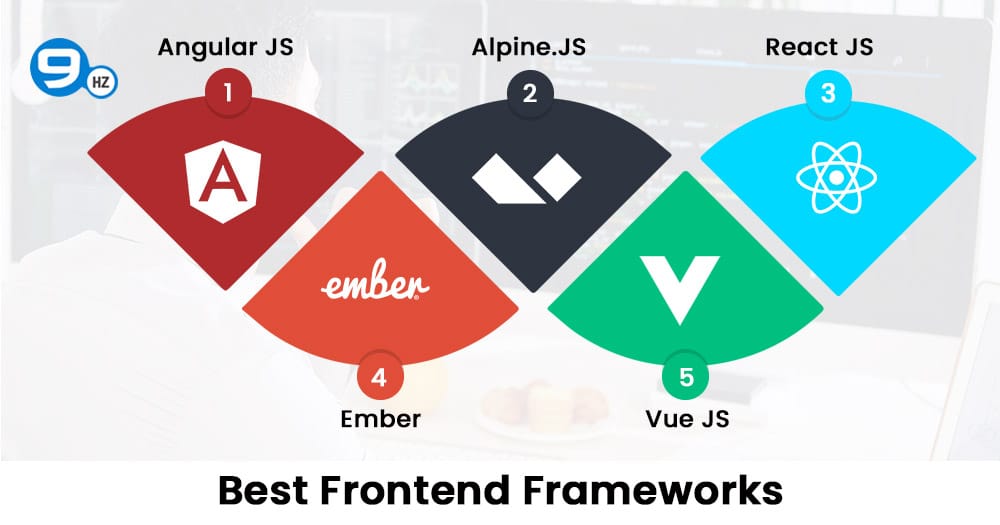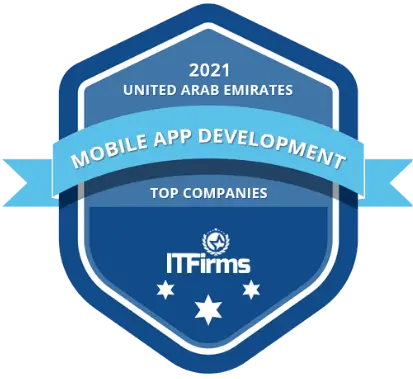Web Development Frameworks: Are you done with Python’s basic programming or with any other language? If that’s the case and you want to update your skills, then we’ve got you covered. Here learning best frameworks for website development to advance your profession as a backend and front-end web developer comes into the picture. To begin your experience, select one of the main frameworks for web development listed below.
Almost all IT firms use web frameworks to construct dynamic online apps instead of writing the code in a specific programming language from scratch. Choosing the most popular web development frameworks is difficult, especially when there are so many to choose from.
That’s why we have handpicked the best frameworks for web development 2025, including both back-end and front-end frameworks.
First Thing First,
What are the Web Development Frameworks?
Frameworks offer developers the tools and functions they need and the rules for designing the architecture of websites, apps, APIs, services, and other solutions. As a result, you can quickly construct the skeleton for your project and then expand it based on the needs.
A framework may also contain utility programs, code libraries, scripting languages, and other tools to aid in creating and integrating various components of a major software project.
Therefore, web development platforms are customizable, which means you can take ready-to-use templates and components and modify them to your individual needs. You may also integrate your own code into the platform.
Hire Certified Web Developers
Request A Free Quote
Types of Web Development Frameworks
Any web application of a backend or server-side component and a front-end or client-side component. As a result, there are web development frameworks for both the frontend and the backend.
Front end Frameworks for Web Development
These are in charge of the user interface, which is the visible portion of a website or application with which end users interact. They are built with frontend programming languages like HTML, CSS, and JavaScript and deal with UX/UI design, templates, code snippets, SEO optimization, user interaction management, and more.
Backend Frameworks for Web Development
These are in charge of the hidden parts of a website or application with which developers communicate. They are concerned with the operation of the server and database, solution logic and architecture, routing protocols, data security, authorization choices, and other issues. Backend programming languages such as.NET, Ruby, Python, Java, and PHP are used to build these systems.
Top Benefits of Using Frameworks for Web Development

Why do the majority of developers rely on frameworks? In a nutshell, since they make it easier to create and maintain web projects. The below are some of the benefits of using the most popular web development frameworks, have a look at them.
1) Economic Benefits
- Rapid development: When starting a project, frameworks save programmers the hassle of reinventing the wheel by performing common tasks from the ground up. Instead, developers utilize pre-written templates and tools to create the project base, saving significant time swiftly. Furthermore, they may better focus on specific features, adding to the overall quality of the final solution.
- Reliability and security: Ready-made components are created and updated by a community of thousands of developers, implying that they have been tried in every potential way. By utilizing them, you may prevent several issues and produce a very stable, trustworthy, and secure solution in a shorter amount of time, much to the delight of your clients.
2) Technical Benefits
- Simplified Maintenance: Frameworks establish a consistent structure for application development, making framework-based apps easier to maintain and refine: any web developer can quickly grasp a standard arrangement of app components and their operational principles and smoothly add functionality or make adjustments.
- Reduced Errors: The community guarantees that framework components are of high quality, so you can use them with confidence in your project. Furthermore, framework techniques typically include the best software engineering principles. As a result, by adhering to these guidelines, you can avoid several design stumbling blocks and reduce defects.
- Better Performance: Framework-based solutions are faster to implement and have a better loading capacity, which is critical for eCommerce solutions. They can also be easily scaled.
Most Popular Web Development Frameworks 2025
A framework is now required for the building and upkeep of websites. With so many options accessible, deciding on one becomes quite tough. We have collated the most popular web frameworks depending on their type, i.e., frontend and backend, together with their numerous key features, pros and downsides, and so on, that are utilized nowadays for simplicity of development.
Best Front-end Frameworks for Web Development

A frontend framework is in charge of what users see on a webpage. HTML, CSS, and JavaScript are the three primary tools for creating a frontend framework. Here are the following five frontend Web Development Frameworks which are mostly used in 2025.
1. Angular JS: Most Popular Web Development Framework
Language: JavaScript/Typescript
Examples: YouTube, Google Translate
Angular is the most popular web development framework that is built on JavaScript, which can be used to create frontend applications or frontend components of full-stack web applications. Google created Angular, which uses the TypeScript programming language, which encompasses all JavaScript does and much more. Angular includes a robust command-line interface (CLI) that allows you to build components rather than manually create them.
Key Features of Angular JS
- Numerous third-party connectors can be readily added. As a result, web developers can increase the overall operation of their websites.
- Angular dependency injection is quite beneficial. Creating dependencies takes effort, but it’s well worth it if you’re working on a large project requiring the site to perform multiple roles.
- Angular apps load faster because they use an ahead-of-time compiler.
- Templates are defined using HTML elements, which improves code readability and speeds up development.
Pros of Angular JS Framework
- Improved design MVC structure
- Highly testable products
- Data binding in both directions
- Lazy loading is supported
Cons of Angular JS Framework
- Steep learning curve
- Steep learning curve
Also Read: Python Mobile App Development Frameworks
2. React JS: Best Web Development Framework
Language: JavaScript
Examples: PayPal, Instagram, Airbnb, Uber
React is the best framework for web development 2025, which was created and is maintained by Facebook; it is technically a front-end library rather than a traditional framework, but developers frequently use it as a framework of sorts. It was the first framework to use a component-based architecture, which was later adopted by famous frameworks such as Vue and Angular, both of which are on this list. React can be used both server-side and client-side. You must read a comparison blog on AngularJS Vs ReactJS.
Key Features of React JS
- JSX makes React not just easy to use, but also delightful. Developers can only write code in JavaScript. They can create a new feature and test it in real-time. In a nutshell, React inserts HTML straight into your JavaScript.
- Components are what distinguishes React. They enable you to deconstruct sophisticated user interfaces. Instead of being concerned about a complex website design, you may split it down into smaller components and begin building the same.
- React uses virtual DOM to determine when to re-render and when to disregard specific DOM elements. It improves the page’s performance. And because the UI responds quickly to a user action, the user experience improves significantly.
Pros of React JS Framework
- Better UI
- Flexibility
- Strong community support
Cons of React JS Framework
- Poor documentation
- Only view part support
3. Alpine.JS: Popular Web Framework
Language: JavaScript
Examples: Pcmag, devdojo
If you want to create a highly interactive SPA, we recommend Vue, React, or Angular. Alpine is the most popular web framework and is preferable if you work on a small project requiring only one or two components. AlpineJS is regarded as one of the best web development frameworks, particularly for server-side applications. Alpine is popular among developers because it leaves the app with a small footprint.
Alpine.JS Key Features
- You have the ability to control the framework effectively. Being developer-friendly, you can focus on developing rather than configuring. Aside from web applications, you may also use them on Android or iOS.
- AlpineJS’s most major advantage is its small size. At the time of writing, the framework was roughly 4KB in size and worked well with your existing frontend templates. It makes no difference what you’re using. Alpine can simply interact with and manipulate the DOM, whether it’s Blade, HTML, or anything else.
- AlpineJS enables you to leverage the declarative and reactive aspects of frameworks such as Vue, React, or Angular at a cheaper cost.
Pros of Alpine.JS
- Localization
- Pagination
- Data encryption
Cons of Alpine.JS
- Full-page caching
- Error logging
4. Vue JS: Front-end Web Development Framework
Language: JavaScript
Examples: Grammarly, Alibaba, Xiaomi, Reuters
Vue, a new open-source front-end framework built on JavaScript, is one of the most promising technologies for creating user interfaces. It is much lighter than other frameworks, making it ideal for dynamic projects and single-page apps.
Vue has a highly customizable and flexible design that allows it to be readily integrated with third-party applications. You can choose from various components, such as using Vue as a library to augment your existing app or as a full-featured framework. You might be interested to explore the comparison guide on Vue.js Vs. Angular Vs. React.
Key Features of Vue JS
- It improves application performance and DOM update efficiency. It tells Vue which parts of the DOM should be re-rendered and which should be left alone.
- Vue CLI simplifies application scaffolding and prototyping, making it a versatile framework for web development. It also saves some amount of time on project development.
- Vue supports reactive two-way data binding, implying that any UI change will affect the data and vice versa.
Pros of Vue JS
- Easy integration
- Excellent tooling
- Readability of code
- Reusability of components
Cons of Vue JS
- Reactivity complexity
- Limited web resources
5. Ember Framework for Website Development
Language: JavaScript
Examples: Twitch, LinkedIn, Accenture, Square
Ember is another open-source most popular Web Development Frameworks to keep an eye on. It can assist you with developing modern user interfaces not just for web solutions but also for mobile and desktop programs that will work on all devices. Ember makes use of the MVVM paradigm.
Ember has a crucial feature in that a testing program is built by default for each new entity. When you use Ember, you can always count on an ever-expanding community of talented developers to release new features and improve the platform.
Key Features of Ember
- Ember is well known for completing similar tasks in a single pass. As a result, high performance is obtained.
- Routing is among the best you can get. Route handlers are enabled on URLs, allowing you to examine various application states. In addition, promises are determined by asynchronous logic in the router.
- Ember provides a comprehensive front-end stack. The framework includes a router, services, and an asset pipeline.
- Ember’s philosophy is “convention above configuration.” Everything is already configured in the framework for you to get started on your project right away.
Pros of Ember Framework
- A Strong Community
- Developer productivity
- Quick website development
Cons of Ember Framework
- Tough to learn
- Sluggishness in popularity
Also Read: Top JavaScript Frameworks
Top Backend Web Development Frameworks

Going ahead, the list below indicates the top web development frameworks 2025 to use for backend web application development. Take a look.
6. Django: Most Poular Framework for Backend
Language: Python
Examples: Google, YouTube, and Instagram
Django is a Python web development framework. Python’s popularity has risen tremendously, which has had a direct impact on Django’s quick acceptance. It follows the DRY pattern and the Convention Over Configuration pattern.
Django provides developers with approaches and tools to assist them in creating a secure website, or it incorporates security within the framework itself, such as preventing code execution in the template layer. Furthermore, Django has several powerful capabilities that set it apart from other backend web development frameworks.
Dedicated Web Developers [Hire in 1 Hr]
Request A Free Quote
Key Features of Django
- It enables versatility through pluggable apps, which allow third-party applications to be readily plugged in.
- Django has a strong level of security by default, sealing flaws that were previously left open for the backend developer to fill.
- Django has been the greatest at documentation since its debut, and it has only become better with current technological innovation. It is also available in numerous languages.
Pros of Django Framework
- Simple to grasp
- High-speed side web development
- Highly scalable and well-documented
Cons of Django Framework
- The components are inextricably linked
- Cannot handle multiple requests
7. Express JS: Top Web Development Framework
Language: JavaScript
Examples: MuleSoft, Accenture, Myntra, Uber
Express is one of the best web frameworks available today. Its success among major organizations can be attributed to the platform’s flexibility and simple aesthetic. Furthermore, it is an open-source framework for the Node.js environment, and Node.js is in high demand nowadays.
Express is developed in JavaScript and includes tools for developing online apps, APIs, and mobile solutions. It is compatible with third-party frameworks.
Key Features of Express JS
- Express allows you to effortlessly scale your web applications to meet your growing needs by adding extra resources and nodes.
- Express is endowed with a large active developer community that is always eager to contribute to the framework’s advancement.
- With only 550 lines of code, the framework is exceptionally light.
Pros of Express JS
- Javascript framework is simple to learn.
- Extensive documentation
- It provides a lightweight middleware module.
Cons of Express JS
Low security
8. Laravel Website Development Framework
Language: PHP
Examples: Cuttlesoft, Resourcifi, RnF Technologies.
Laravel is a Model-View-Controller framework that uses the most recent PHP technologies. It was created with the intention of making the development process more fun. Laravel offers a beautiful syntax that simplifies basic chores like authentication, routing, and caching. It may appear complicated at first due to the extensive documentation, but once you get the feel of it, designing the backend of an application will be a breeze.
Key Features of Laravel
- Laravel facilitates the separation of the display layer from the business logic, resulting in a pleasant user interface and good performance
- Laravel’s simple yet powerful Blade template engine adds no overhead to apps while providing useful shortcuts to more standard PHP methods.
- Modular development and pre-built functions allow developers to get to market faster, giving them a considerable advantage over competitors.
Laravel Framework Pros
- Wide scope
- Rapid development
- Improved technical vulnerabilities
Laravel Framework Cons
Less inbuilt support
9. Spring Framework for Website Development
Language: Java
Examples: Deleokorea, Intuit, Zalando, MIT
Pivotal Software’s Spring Framework is one of the most popular web frameworks. The Spring framework, which is built for the Java platform, allows you to create simple, flexible, and quick applications and systems.
Despite the fact that it does not require any specific programming pattern, this backend framework has gained prominence in the Java community with the advent of the Enterprise JavaBeans model. A Java program can use its core functionality, but extensions aid in creating apps on top of the Java Enterprise Edition platform.
Key Features of Spring
- In terms of size and capability, the Spring Framework is relatively small.
- The Spring framework creates and manages application object lifecycles and configurations.
- One of the best aspects of this framework is that it does not attempt to tackle problems already been solved. It just attempts to include them into its framework, which provides a solution to more significant issues.
Pros of Spring
- Flexible Spring framework setup
- Simple research and testing
- Excellent and powerful abstraction
Cons of Spring
- Integration of third parties is very complicated
- Needs a lot of expertise
10. Rails Framework
Language: Ruby
Examples: Crunchbase, Ask.FM, Bloomberg
Ruby on Rails is a server-side Model-View-Controller framework that is interoperable with popular front-end frameworks such as React or Vuejs. The key premise of Ruby on Rails is that each snippet should have a single submission within a system so that the code is cleaner and performs properly. As a result, developers write less code and hence develop more quickly. Ruby on Rails includes built-in security features to protect against threats such as Cross-Site Scripting, SQL Injection, and Cross-Site Request Forgery.
Key Features of Rails
- Ruby on Rails is an entirely free and open-source framework.
- The framework is installed and activated by default, along with various security measures. When you utilize Ruby in Rails, you are following a secure development procedure.
Pros of Rails
- A plethora of libraries and tools
- Rapid advancement
- Automation-enabled
- Massive community support
Rails Framework Cons
Slow Processing
Conclusion: Most Popular Web Development Frameworks
Here you have come to an end: the best framework for web development 2025, with which developers are entrusting their projects. You can safely use any of these web development frameworks, depending on your specific requirements.
Hire web application development services from The NineHertz (a major offshore software development business and one of the top outsourcing firms for startups) employs some of the greatest web application developers who provide customers with the best web application development solutions. Please contact us if you have any questions.
Great Together!









